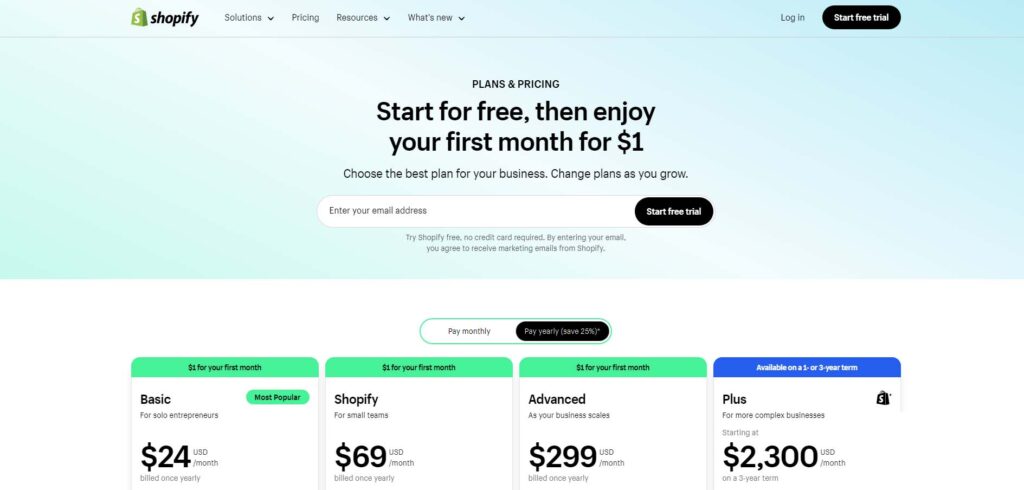Introduction
Dropshipping is revolutionizing the world of eCommerce, allowing entrepreneurs to run online stores without holding inventory. Shopify dropshipping stands out as a top dropshipping platform due to its user-friendly interface and powerful tools. This guide will walk you through everything you need to know to start your successful Shopify dropshipping business with just USD 1.
What is Dropshipping?
Dropshipping is a retail fulfillment method where a store doesn’t keep the products it sells in stock. Instead, when a store sells a product, it purchases the item from a third party and has it shipped directly to the customer. This means you, the retailer, don’t have to handle the product directly.
Why Choose Shopify for Dropshipping?

1. Ease of Use
Shopify‘s platform is designed for simplicity. You can set up a store quickly, even if you have no technical skills. The intuitive interface makes managing your store straightforward.
2. Comprehensive App Ecosystem
Shopify boasts a robust app marketplace with tools to enhance your dropshipping business. Apps like Oberlo and Spocket integrate seamlessly, helping you find suppliers, manage orders, and automate tasks.
3. Reliable Customer Support
Shopify offers 24/7 customer support, ensuring you can get help whenever you need it. This is crucial for resolving any issues that may arise with your store or orders.
Getting Started with Shopify Dropshipping
1. Niche Selection
Choosing the right niche is critical. Focus on a market segment with high demand and low competition. Use tools like Google Trends and social media to identify trending products.
2. Setting Up Your Shopify Store
- Sign Up: Start by creating an account on Shopify.
- Choose a Theme: Select a professional, responsive theme that suits your brand.
You can use expert support to set up all of this professionally and maximize success by hiring a Shopify expert.
3. Finding Suppliers
Use apps like Oberlo, Spocket, or AliExpress to find reliable suppliers. Look for suppliers with positive reviews and proven track records.
4. Adding Products
Import products to your store using your chosen app. Ensure product descriptions are detailed and include high-quality images. Optimize your product pages for SEO to attract organic traffic.
Marketing Your Dropshipping Store
1. Search Engine Optimization (SEO)
Optimize your site for search engines. Use relevant keywords, create high-quality content, and ensure your site is mobile-friendly. A blog can significantly boost your SEO efforts by providing valuable content related to your niche. You can easily leave this matter to a professional who are expert in SEO.
2. Social Media Marketing
Leverage platforms like Facebook, Instagram, and TikTok to reach your audience. Share engaging content, run targeted ads, and interact with your followers to build a loyal customer base. Hire someone to save time and to get the best result.
3. Email Marketing
Build an email list from day one. Use email marketing to inform subscribers about new products, promotions, and updates. Tools like Mailchimp integrate well with Shopify to automate your email campaigns. Experts are here.
Learn more about Email Marketing here.
4. Paid Advertising
Consider using Google Ads or Facebook Ads to drive traffic to your store. Paid advertising can be highly effective when combined with organic strategies.
Managing Your Dropshipping Business
1. Order Fulfillment
Once a customer places an order, your dropshipping app will notify your supplier to ship the product directly to the customer. Monitor this process to ensure timely delivery.
2. Customer Service
Provide excellent customer service to retain customers and encourage repeat business. Respond promptly to inquiries and resolve issues efficiently.
3. Analyzing Performance
Use Shopify’s analytics tools to track your store’s performance. Analyze sales data, customer behavior, and marketing metrics to make informed decisions and improve your business strategy.
Common Challenges and How to Overcome Them
1. Finding Reliable Suppliers
Research thoroughly and start with small orders to test suppliers. Building relationships with reliable suppliers is key to your business’s success.
2. Handling Returns and Refunds
Have a clear returns policy and work closely with your suppliers to manage returns smoothly. Good communication can mitigate many issues.
3. Staying Competitive
Stay ahead of trends and continuously update your product offerings. Regularly analyze your competitors and find ways to differentiate your store.
Conclusion
Dropshipping with Shopify offers a lucrative opportunity to build a profitable online business with minimal upfront investment. By following this guide and leveraging the tools and resources available, you can create a successful dropshipping store that thrives in the competitive eCommerce landscape.
Confused how to ….
